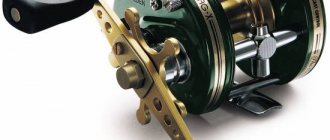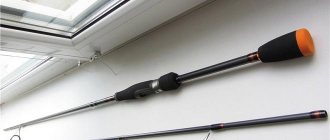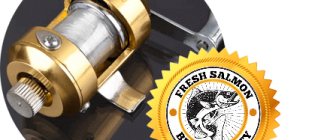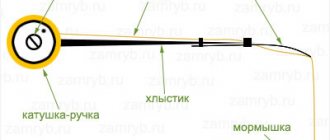I think that every progressive spinner sooner or later comes to casting tackle. At first, everyone faces difficulties in mastering it, and casting suffers especially badly. “Cartoon” periodically “bears”, your nerves are strained to the limit and you want to drop everything and pick up the good old spinning reel, but you are constantly tormented by interest and fishing excitement. Ultimately, you take a spinning rod equipped with a multiplier reel and go on the water. And so on every day, until all the movements are “polished” and brought to the point of automatism, then there can be no talk of any beard. Having mastered casting, you realize that your level is growing, and new skills and abilities are transformed into invaluable experience.
I, like many other spinning players who want to master the “multi”, went through all the hardships and, in order to deprive a beginner of unwanted and sometimes even offensive mistakes, I want to share my experience of using this tackle.
Since I'm talking about casting, I think it's worth saying a few words about how I became acquainted with this gear. And it was like this. I watched another video supplement to the magazine “Fish with us”. As I remember now, a story dedicated to pike fishing in the Middle Volga. The main roles are Alexey Shanin and the animator, and, of course, the pike. The fact that the multiple world spinning champion fishes with a “cartoon” got me excited. And literally the next day I purchased the first casting kit.
To be honest, at that time I was not yet ready to spend money on buying expensive gear, especially what if I didn’t like it? Therefore, I decided to make do with a Chinese spinning rod and have the same reel to match it. Frankly, I forgot what those “tools” are called, but that doesn’t matter. Despite many failures, I still decided to buy a decent set. It looked like this: a Banax Spurt spinning rod, 2.13 long, Fast action and 5-18 grams. Daiwa EXCELER 100 reel with a “gear ratio” of 6.3:1. At that time, this kit was the height of bliss. I would not have parted with this spinning rod and reel to this day if more decent players had not appeared, but that’s another story. And now, to the point.
Selecting a spinning rod
You should take the choice of your first casting rod very seriously. I would not recommend starting a beginner with classic bass “pegs”, since a rigid system will steal a certain number of meters from you when casting. And this is not because the spinning rod is bad, but because your casting technique is to blame, which, I am sure, will leave much to be desired. At least I haven’t met a person who, having picked up casting tackle for the first time, cast the bait over the horizon, it’s simply impossible. An excellent option for “testing the pen” would be a rod with a slow action, labeled as ModFast. Such a spinning rod is loaded when casting almost along its entire length. Even the butt is included in the work. Due to the features of such a form, the bait is given greater acceleration, therefore, the flight range increases, and oh, how a beginner will miss this at first.
As for the length, everything is simple here; you should not choose a rod that is too long or too short. Limit yourself to a length range of 198 to 228 centimeters. I assure you that this length is more than enough for the first time. Moreover, due to its “noodles”, it will be simply inconvenient to fish with a long rod with a slow action.
The test limit that determines the power of the spinning rod should not be too large. It is most convenient to master casting tackle in the test range up to 18-24 grams. This test fits exactly within the boundaries of the fairly popular Medium-Light class. And since you would prefer to try with casting the same baits that you used to catch with a classic spinning rod, I think that even a 120 mm wobbler will pull such a spinning rod without any problems. Again, in modern spinning fishing, many rods are usually “signed”. For example, the range of Pontoon 21 Seven&Half spinning rods is formed in such a way that each model is signed, be it a classic or a casting that excites us. From this line, an excellent “player” would be the model marked SHC764MF 7’6″/2.28 5-17.5 5-12 ModFast Plug manipulation. This model is well suited for animating our favorite plastic and silicone baits. And since the build is moderatefast, the spinning rod throws far, which is very important for a beginner, and for sure.
At first, when you take timid steps in casting fishing, you will greatly lack versatility in gear, and the above-mentioned model is a real all-rounder. I myself regret that I did not start mastering the “cartoon” with this model.
Now, summarizing what was said above, let’s draw some small conclusions.
- To begin with, you should avoid long spinning rods; stop at a length of 228 centimeters.
- Choose a rod with a slow action, it will forgive mistakes when casting.
- Pay attention to universal models.
- The test limit should not be more than 24 grams.
Choosing a rod
Material
Modern manufacturers mainly use synthetic materials to make casting fishing rods.
Basic materials for making casting fishing rods:
- fibers;
- carbon fiber;
- fiberglass;
- graphite.
In order to choose the right material for a fishing rod, you need to know what properties these materials provide:
- Fiberglass adds strength and flexibility, but also adds a lot of weight to the blank.
- Carbon fiber provides a good degree of resistance and does not break.
- Graphite gives hardness and rigidity to the rod. Most often it is combined with carbon fiber.
Build
The structure of casting fishing rods is:
- parabolic;
- semi-parabolic;
- bending of the upper part of the fishing rod;
- bend of the upper part of the form.
For fishermen who do not yet have much experience, experts recommend purchasing parabolic and semi-parabolic fishing rods based on their structure.
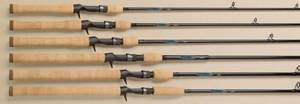
Length
Choosing the right fishing rod length depends on the location and method of fishing. There are the following rules for choosing the correct fishing rod length:
- Short fishing rods are best used when fishing from a boat or when casting with bait along the shore. Short rods are very sensitive, which allows them to control the movement of the bait. Fishing rods from 180 to 200 cm long are considered the most convenient.
- Fishing rods of medium length are considered universal. These fishing rods are well suited for fishing in almost any area. They are recommended to be purchased by inexperienced fishermen, since they are easier to handle than others.
- Long fishing rods are usually used for fishing from banks or bridges. Because they allow you to cast as far as possible. Long fishing rods are considered to be from 220 to 290 cm.
Power
Choosing a fishing rod based on its permissible power:
- To fish with baits weighing up to 20 grams, you need to use a light fishing rod. The reel for this type of fishing rod is filled with fishing line with a permissible load of up to 10 kg.
- To fish with baits weighing up to 50 grams, you need to purchase a fishing rod of the medium category. The fishing line for this type of fishing rod should be taken with a load of 10 to 15 kg.
- For fishing with lures up to 130 grams, a fishing rod from the heavy category is best suited. It is better to take a line for such a fishing rod with a load of 20-22 kg.
Test
There are such tests:
- heavy – up to 40 g;
- medium-heavy – test up to 27 g;
- medium – up to 21 g;
- light medium – up to 20 g.
In order to choose the right fishing rod test, you should know this ratio:
- for catching fish from 1.5 kg, the best test is from 20 g;
- for catching fish up to 1 kg, the best test is up to 20 g;
- for catching fish up to 350 g, the best test is 10 g.
Rings
Casting rod rings must have the following features:
- smaller diameter than conventional spinning rods;
- low leg, thanks to which the tackle gains greater sensitivity;
- the rings should be located on top of the fishing rod.

His Majesty "cartoon"
This is perhaps the most difficult thing a beginner will have to face. Currently, on the Internet you can find a lot of information regarding the multiplier reel. When I was just starting to get acquainted with this gear, I decided for myself that I would take the easiest path, namely, I would take a “mult” with a magnetic braking system. The magnetic brake system is simple in that we don't have to constantly open the reel body and manually turn the weights on or off. The coil with the magnetic system has an external relay that allows you to select the required value. It varies from manufacturer to manufacturer, but most often there are 10 positions on the relay, as, for example, on my old Daiwa EXCELER 100. Counting starts from 0. 0 - there is no force, and the magnets do not slow down the spool, therefore, each subsequent number increases braking. What is good about the magnetic brake system? First of all, it is easy to set up, and secondly, the magnetic system is great for all types of baits with some reservations. So, for example, it is better to throw non-sailing jig baits with a magnet that has a magnet. Such reels are also friendly with wobblers, but to be honest, a little worse.
Another thing is the centrifugal system. It differs only in that it is designed for use with sailing baits, which include everyone’s favorite wobblers. Not to say that she throws lead weights poorly, but there is still some discomfort, so keep that in mind. I repeat once again that “they are good in their own way.”
In addition to the above-mentioned braking systems, there is also a second one, presented in the form of an axial brake. All multipliers are equipped with “Osevik”. The axial brake is responsible for the free movement of the spool, namely, whether it will rotate quickly or slowly. “Axis” prevents excessively sharp rotation of the spool at the start and slows down the entire cast. It plays the role of a kind of stabilizer. As for the axial brake, it is identical on reels from different manufacturers, which cannot be said about magnetic and centrifugal systems.
Our story about the casting fishing rod
Fishing with casting equipment has centuries-old traditions.
At the beginning of the 21st Century, when the craze for jerk baits began in Europe, the fashion for casting fishing was experiencing its heyday. Beginners are frankly afraid of the difficulties associated with servicing multiplier reels, although upon closer acquaintance it turns out that using a multiplier is easier than a regular spinning reel.
A casting rod looks similar to a spinning rod. The fundamental difference is the multiplier type reel mentioned above. It is installed in such a way that the fisherman can see it. The reel seat is adjusted for this reel. The casting rod handle is equipped with a special trigger, which allows you to simultaneously hold the rod handle and operate the reel with your thumb.
The passage rings in the casting form have a smaller diameter, are located on short legs and, unlike a spinning rod, are located on top.
Compared to spinning rods, casting blanks are more ergonomic, have greater sensitivity, and better power characteristics necessary for hooking and landing fish. This rod has the best characteristics for casting and controlling the bait during retrieving.
This indicator characterizes the bending of the rod under load. Casting forms are characterized by four main types of formation. The British classification system divides casting rods into:
- Slow – the entire rod bends (parabolic action).
- Moderate – 1/2 of the rod goes to bend (semi-parabolic action).
- Fast – the upper 1/3 of the rod goes to bend.
- ExtraFast (ExFast) – the upper 1/4 of the form is used for bending.
Beginners are recommended to use semi-parabolic rods at first.
The use of multiplier reels in conjunction with casting forms is completely justified. With their help, for example, it is much easier to throw jerks. Due to the multiplication, the whips acquire additional power and the likelihood of using monofilament fishing line.
By the way, some types of wobblers are designed specifically for monofilament, which gives them a unique game. In addition, catching and landing trophy specimens requires the use of a line with a large cross-section, but the inertia-free system can twist it strongly, unlike multipliers.
What other advantages:
- On jigs it is possible to conduct the line “in line” and feel the bite with either hand. You can read about this in the article “Spinning rods for jig fishing from ultra-light to super-heavy.”
- When working with heavy baits on spinning baits, backlashes often form, which reduces the smoothness of the ride. Multiplier reels are free of this.
- Throws into the wind can result in a “beard” on the lack of inertia.
- The service life of the multiplier is much longer, for which the reel is nicknamed “indestructible”.
- As the diameter of the line increases, the casting distance does not decrease.
- When trolling, a counter installed on the reel allows you to know how much line is thrown into the water.
With all the advantages of a multiplier reel, it also has disadvantages. If we put aside the higher cost, we cannot help but mention that it works much worse with very light baits, and the low reeling speed makes stepwise retrieving difficult.
So what is more - pros or cons, if even in cold weather the lubricant freezes on the multiplier, making its operation impossible? Let's put it this way: the reel is capable of tactilely transmitting unique sensations to the angler's finger - light pokes from the fish, and even any protrusion in the bottom topography.
Bait reels are divided into high-profile, or barrel, bait reels, which can effectively handle weights of 15-90 grams, and low-profile, or soap reels, which are designed for baits weighing 5-20 grams.
The more expensive it is, the further it throws?
Is there a certain dependence on price and casting distance? Well, of course there is. An expensive multiplier is much more convenient to drive, it throws further and has more “bells and whistles” in it, and from a purely aesthetic point of view, having an expensive multiplier is tantamount to driving a Mercedes. K. Kuzmin once said that “a cheap cartoon is a pig in a poke.” There is some truth in his words, but, based on my experience, I can say that the niche of cheap low-profile reels has its own very, very worthy players. Take Banax Zest, for example. For the money it’s just an excellent reel. Or the repeatedly mentioned Daiwa EXCELER 100. Since I also started with an inexpensive cartoon, I can only say one thing - to each according to his capabilities. Sooner or later you yourself will come to better and more expensive gear.
When it comes to casting distance, many factors come into play. This includes the thickness of the cord, the action of the rod, and its length, but the most important thing is the equipment of the multiplier. The number of bearings and the material from which they are made directly affects the casting range in reels of both the expensive and “popular” segments. As standard, all “mults” are equipped with metal bearings, but if desired, you can do a little tuning and replace them with ceramic ones, then the flight distance of the bait will increase noticeably.
Even the weight of the spool plays an important role, and often advanced “multi-drivers” change the standard spool to a lighter one. By the way, perforation on the spool is good not only because it allows you to secure the fishing line, but also reduces weight.
If you buy an inexpensive reel, you will still face the problem of casting range. No matter how hard you try and get out of your pants, take it for granted, since a miracle will still not happen.
I would recommend mastering the multiplier with non-sailing baits. A jig or retractable leash is excellent for such purposes. Start throwing about 10 grams or more, and then see, maybe your reel will cope perfectly with lighter loads, but based on my own experience, I can definitely say that a cheap multi-reel can cope with light baits up to C grade.
Casting technique
Casting with a multiplier reel differs from casting with an inertia-free reel. When casting with a multicast, the spool is controlled with your finger. This is necessary to avoid getting a “beard”, especially when casting light baits.
To solve the problem with the “beard”, you need to train, honing your casting technique, releasing the brakes more and more each time. The cast should be smooth; sudden movements will cause shooting. When casting, the rod should be in line with the fishing line, thus reducing the friction of the cord on the guides. It is easier to master cartoons with jig heads.
It is better to cast from behind your head, holding the reel sideways and not horizontally. To begin mastering the casting technique, you need to wind the fishing line on a reel and attach a jig head with a bright twister, or a weight with a colored ribbon to control the casting distance.
First you need to put a bait of about 20 grams, no less, so that the windage is minimal. Then, you need to see how many weights are under the left cover. To begin with, set 3. Select the axial play of the spool and tighten the screw 1/3 of a turn. After casting, gradually release the brake to increase the casting distance.
After leaving for about half an hour, remove one weight, then another. Thus, a feeling of gear will come.
In the video you can see how a beginner tries to throw a cartoon:
You can use other casting methods with casting rods:
- Pitching is the precise casting of the bait from under you, if this cannot be done otherwise, the length of such a cast does not exceed 15 meters.
- Rollcast - casting with a loaded rod tip. Only the tip of the spinning rod works.
- Flipping is an accurate casting with a short rod, used for catching bass with a spinning rod, but is not popular among our fishermen.
Many people note that jig fishing from a boat with multis is much more convenient than fishing from the shore. This is explained by the fact that from the shore you need to adapt to the wind and windage of the bait. Also, if you fish from the shore using a meat grinder, you can use a larger number of baits.
In order to fish from the shore with a spinning rod, when casting from behind the head, you need to make a large swing, and for this you need space free from trees and bushes. But some people solve this problem by specially carrying a saw when fishing to cut down small bushes. Fishing from the shore with casting gear is no less popular than fishing from a boat.
Folk saying: The better the morning bite, the worse the fishing will be in the evening and vice versa
Source: KakUlov.ru
“Braided or fluorescent”?
“Darling, I have nothing to wear - what a shame.” Girls, I quoted you, if you knew what the choice of braided cord or fluorocarbon is... You stand in the store and look at both. You begin to count the pros and cons of the “cord” in your head, then fluorocarbon.
They whisper in your left ear - take “flur”, and in your right ear - “braid”. But let's think logically. What are the disadvantages of braided fishing line? The first and, perhaps, the most important thing for me is that after a certain amount of time it begins to fray. The second drawback is that braided fishing line does not have elongation, therefore, the shock-absorbing properties are reduced, which leaves a certain imprint on the number of bites realized. The advantages include the same stretchability, which is practically non-existent. If there is no stretchability, then the sensitivity increases significantly. With a small diameter it has a large breaking load. Here are the main features of all braided “cords”.
Fluorocarbon is a different story. It has minimal stretch compared to other monofilament lines. Invisible in water. Shock-absorbing properties are good. Flur is often used in difficult conditions, for example when fishing in rocks. The use of braided fishing line becomes impossible, as it will rub against the stones and sooner or later will break due to abrasion. Behind the “wickerwork”, alas, there is such a sin. Plus, fluorocarbon fishing line outperforms a cord of the same diameter in casting range. “Flur” does not whistle so much in the rings.
I use fluorocarbon line very infrequently, since I rarely fish in very difficult conditions, and the sensitivity factor bothers me, to put it mildly. In combination with a slow action rod, we get a tackle that lives its own life. There is no sharpness of playing. Yes, the number of trips is minimized, but I go fishing for the thrill, and not to see how the fishing line and rod will do all the work for me. If you want to put up with it, go ahead, but I'm still loyal to the cords.
Another very important point that a beginner needs to know is the diameter of the fishing line being wound. Start with a thick braid around 18-22 lb, as beards will still form due to inexperience. Also, do not rule out possible shootings. With a thick “cord” there are practically no shootings, but they are still present, and in this case the “flur” wins over the cord. Due to the fact that fluorocarbon is also a fishing line, at the moment of a sharp start and rapid braking due to a dash, the “fluor” stretches, and the bait remains in place, and the braided fishing line can shoot off. Draw your own conclusions, I won’t recommend anything specific. This is equivalent to one saying that a Volkswagen is good, while the other prefers an Audi.
The best casting rod for twitching
You will have to put some effort into choosing a fishing rod for twitching. You can use short and long rods when fishing, a short one is too sensitive, you won’t get tired of such a rod. The rod should be light; due to sharp jerks, only braid is used, and if you are fishing for pike, you also need a leash.
Lures are made of silicone and plastic; the wobbler will make very sharp jerks, changing its direction. The length for coastal fishing should be from 2.1 to 2.4 meters, if fishing is done from a boat, then from 1.8 to 2.1 meters. For long casts, it is advisable to have rods no more than three meters.
One of the presented models from the category of the best twitching casting rods, chosen by experienced anglers, is the Sabaneev Master Spin210. This is a plug rod, test from 3 to 15 grams, length 210 centimeters, weight 197 grams. When transported, it is 110 centimeters long. The rod is made of carbon fiber, the rings have flint inserts, the handle is made of cork. On the form in the area of the handle there is a loop to which the bait is attached. The Sabaneev Master Spin210 rod has high strength and fishing is easy.
Sensitivity and other advantages of “mult”
They say that multiplier tackle is more sensitive than regular tackle. In fact, that's how it is. “Mult” in this regard outperforms “inertia-free”. And this difference is noticeably noticeable. If it were possible to shoot a “multi” in the same way as a “meat grinder”, I would opt for a multiplier, but due to its casting feature, the mult loses in range to a spinning reel. Although, I did a little experiment. I wound a 20 lb fishing line on the “mult” and on the “meat grinder”. Sparing no effort, he invested in casting. If with the “inertia-free” there was a large dependence on the diameter of the cord, then with the multiplier there is practically no such thing. We conclude: the multiplier throws better with thick lines.
Plus, the multiplier tackle immediately starts working, which cannot be said about the inertia-free reel. Often, predator attacks follow when the bait splashes down, and here the “mult” is beyond any competition. Casting tackle is also good when you are planning to make a quiet cast. Placing the bait carefully under the opposite bank, or in a window of grass, without making much noise, is possible only with the use of a multiplier.
Often an angler finds himself in difficult conditions when a strong side or head wind blows. So, if we had a classic tackle, then a large arc would form on the cast and we would have to unwind the excess line. This is not the case with the multi, it is easier for them to catch in the wind, and it does not have such a large arc due to its technical features.
Now let's summarize. What should a newbie pay attention to? First of all, this is the choice of fishing rod. I repeat once again: well-chosen tackle will forgive inevitable mistakes. The second is the coil. Well, it’s more complicated here, and you can’t argue with that. I would still start with the magnetic system due to the fact that it is easier to learn. But the fishing line or “cord” is a purely personal matter; it is only worth mentioning that the first steps in casting fishing should be taken with the thick size of the fishing line you have chosen.
I hope that the article turned out to be informative and, based on my experience, you will do everything right and love casting.
What is a baitcasting reel?
Multiplier fishing reels are one of the modifications of inertial reels for spinning rods. Such reels are partially equipped with mechanisms and components borrowed from the designs of inertia-free spinning reels.
Multiplier fishing reels are quite difficult to use. To successfully fish with a “multi”, an angler will need well-developed fishing skills. These skills only come with experience. Therefore, to learn how to effectively use a baitcasting reel for a spinning rod, you need to be patient and practice more.
Experienced fishermen choose fishing with a baitcasting reel for the following types of fishing:
• Trolling. To hunt fish from a motorized floating vehicle (a boat with a motor, for example), “mults” can be used both on rods for fishing in fresh water and on rods for sea hunting. In Russia and other CIS countries, pike trolling is popular using fishing rods (spinning rods) with multiplier reels.
• Plumb fishing. Fishermen often resort to this type of fishing in winter. The popularity of using “cartoons” for vertical fishing is observed in Japan and the Russian Far Eastern region. In these regions you can catch a serious predator. Plunge fishing is also popular among those who like to catch pike perch or pike perch.
• Jerkbait. This type of fishing originated in the United States of America and is gradually conquering the countries of Europe and Asia. A characteristic feature of this type of fish hunting is artificial bait. As a rule, such baits are designed for large, predatory fish.
• Twitching. Fishing with jerk fishing rods equipped with multiplier reels is usually carried out when hunting large fish. Fans of fishing skills call the process of twitching large fish one of the most interesting types of fishing.
• Casting fishing. This is the type of fishing in which baitcasting reels are used much more often than spinning spinning reels.
Many fishermen consider the skill of fishing with a multiplier reel to be the highest aerobatics of the fishing craft.
Methods of fishing with casting spinning rod
The essence of fishing with a spinning rod is to cast bait over a certain distance to the intended location of a reservoir or river. Then, winding the fishing line onto the spool of the reel, it gives the bait movement. This movement provokes the fish to grab the bait, provoking the predator instinct.
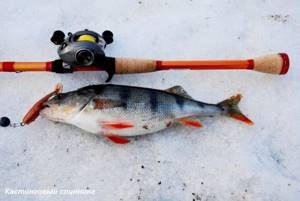
The most important parts of this fishing are: the movement of the bait, the correct placement of the bait, the shape and color of the bait itself. When fishing with a casting spinning rod, it is the bait that sends a set of vibrations to the fish, and then the fish looks at the color of the bait.
To master spinning fishing, you need to learn how to throw the bait into a precisely designated place. Throwing a bait is a strong swing of a rod. When the bait splashes down, it begins to move through the water, the angler turns the reel handle and the fishing line pulls the bait.
This is where the main thing in wiring begins - the bait must be exactly like a fish in its movement. Only then can a bite occur. The act of placing the bait in the water is the basis of spinning fishing. It consists of complex actions of the fisherman, here are some of them:
- hold the rod at an angle of 45 degrees to the horizontal;
- this angle can change, but never align the rod with the fishing line;
- You cannot hold the rod with both hands;
- Do not allow the line to weaken, otherwise you will lose control of the bait.
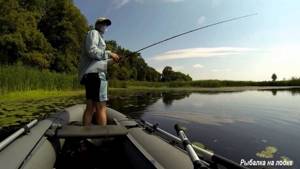
The moment a predator grabs the bait is a joyful and exciting moment. Not every angler can remain calm when a fish is on the hook. In order to distinguish the touch of a bait on the bottom from a pike grabbing it, considerable practical experience is needed.
If the spinning angler quickly notices a bite, then a hook is needed, strong and fast. This is especially necessary when hooking at a distance, when the grip itself is dampened by the elasticity of the fishing line.

